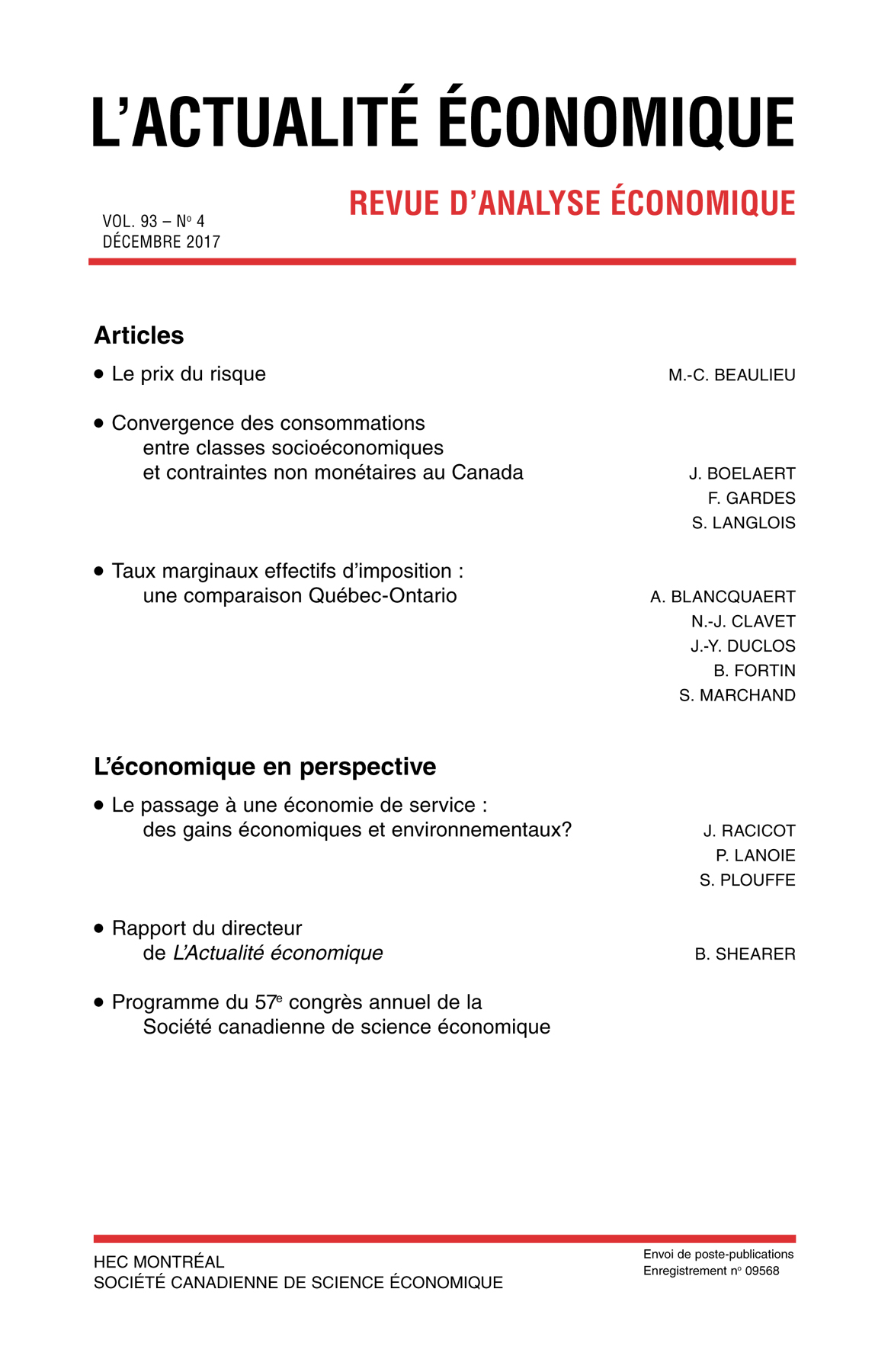Abstracts
Résumé
Dans cet article, j’exploite l’approche développée par Beaulieu, Dufour et Khalaf (2013, 2017) pour montrer comment une méthode robuste aux problèmes d’identification et correcte en échantillons finis peut être utilisée afin d’identifier les facteurs à incorporer dans un modèle d’évaluation d’actifs dans le but de mieux estimer le prix du risque. En fait, lorsque l’incertitude entourant les paramètres du modèle du calcul du prix du risque est importante, elle peut changer de façon significative les décisions d’investissement et de financement. L’approche développée par Beaulieu, Dufour et Khalaf (2013, 2017) permet d’établir conjointement si un modèle est rejeté ou non et s’il est identifié ou non. Trois cadres d’analyse mesurant le prix du risque sont comparés.
Appendices
Bibliographie
- Beaulieu, M.-C., J.-M. Dufour et L. Khalaf (2007), « Multivariate Tests of Mean-variance Efficiency with Possibly Non-Gaussian Errors : An Exact Simulation-based Approach », Journal of Business and Economic Statistics, 25 : 398-410.
- Beaulieu, M.-C., J.-M. Dufour et L. Khalaf (2013), « Identification-robust Estimation and Testing of the Zero-beta CAPM », The Review of Economics Studies, 80 : 892-924.
- Beaulieu, M.-C., J.-M. Dufour et L. Khalaf (2017), « Weak Beta, Strong Beta: Multi-factor Pricing and Rank Restriction », Document de travail.
- Beaulieu, M.-C., J.-M. Dufour et L. Khalaf (2016), « Less is More: Testing Financial Integration Using Identification-robust Asset Pricing Models », Journal of International Financial Markets, Institutions & Money, 45 : 171-190.
- Beaulieu, M.-C., L. Khalaf et O. Melin (2017), « Do Catastrophe Bond Mutual Funds Constitute Zero-beta Investments? : Identification-robust Evidence », Document de travail.
- Black, F. (1972), « Capital Market Equilibrium with Restricted Borrowing », The Journal of Business, 45 : 444-455.
- Black, F., M. C. Jensen et M. S. Scholes (1972), « The Capital Asset Pricing Model: Some Empirical Tests », in Jensen, M. C., Studies in the Theory of Capital Markets, p. 79-121.
- Blume, M. E. et I. Friend (1973), « A New Look at the Capital Asset Pricing Model », The Journal of Finance, 28 : 19-34.
- Campbell, R. H., Y. Liu et H. Zhu (2016), « …and the Cross-section of Expected Returns », The Review of Financial Studies, 29 : 5-68.
- Chen, N.-F., R. Roll et S. A. Ross (1986), « Economic Forces and the Stock Market », The Journal of Business, 59 : 383-403.
- Cummins, J. D. et M. A. Weiss 2009), « Convergence of Insurance and Financial Markets: Hybrids and Securitized Risk-transfer Solutions », Journal of Risk and Insurance, 76 : 493-545.
- Dufour, J.-M. (1997), « Some Impossibility Theorems in Econometrics, with Applications to Structural and Dynamic Models », Econometrica, 65 : 1365-1389.
- Dufour, J.-M. et C. Hsiao (2008), « Identification », The New Palgrave Dictionary of Economics, 2e édition.
- Fama, E. F. et K. R. French (1992), « The Cross-section of Expected Stock Returns », Journal of Finance, 47 : 427-465.
- Fama, E. F. et K. R. French (1993), « Common Risk Factors in the Returns on Stocks and Bonds », Journal of Financial Economics, 33 : 3-56.
- Fama, E. F. et J. D. MacBeth (1973), « Risk, Return, and Equilibrium: Empirical Tests », The Journal of Political Economy, 81 : 607-636.
- Gibbons, M. R. (1982), « Multivariate Tests of Financial Models », Journal of Financial Economics, 10 : 3-27.
- Gibbons, M. R., S. A. Rosset et J. Shanken (1989), « A Test of the Efficiency of a Given Portfolio », Econometrica, 57 : 1121-1152.
- Gollier, C. (2016), « Valorisation des investissements ultra-longs et développement durable », L’Actualité économique, 92 : 667-701.
- Gospodinov, N., R. Kanet et C. Robotti (2013), « Misspecification-robust Inference in Linear Asset Pricing Models with Irrelevant Risk Factors », Federal Reserve Bank of St-Louis, Working paper no 1698076877.
- Jensen, M. C. (1968), « The Performance of Mutual Funds in the Period 1945-1964 », The Journal of Finance, 23 : 389-416.
- Kan, R., C. Robotti et J. Shanken (2013), « Pricing Model Performance and the Two-pass Cross-sectional Regression Methodology », The Journal of Finance, 68 : 2617-2649.
- Khalaf, L. et H. Schaller (2016), « Identification and Inference in Two-pass Asset Pricing Models », Journal of Economic Dynamic and Control, 70 : 165-177.
- Kleibergen, F. et Z. Zhan (2015), « Unexplained Factors and their Effects on Second Pass R-squared’s », Journal of Econometrics, 1 : 101-116.
- Kraus, A. et R. H. Litzenberger (1976), « Skewness Preference and the Valuation of Risk Assets », The Journal of Finance, 31 : 1085-1100.
- Lewellen, J., Nagel, S. et J. Shanken (2010), « A Skeptical Appraisal of Asset-pricing Tests », Journal of Financial Economics, 92 : 175-194.
- Lintner, J. (1965), « The Valuation of Risk Assets and the Selection of Risky Investments in Stock Portfolios and Capital Budgets », The Review of Economics and Statistics, 47 : 13-37.
- MacKinlay, A. C. (1985), « On Multivariate Tests of the CAPM », Journal of Financial Economics, 18 : 341-371.
- Merton, R. (1973), « An intertemporal Capital Asset Pricing Model », Econometrica, 41 : 867-887.
- Mossin, J. (1966), « Equilibrium in a Capital Asset Market », Econometrica, 34 : 768-783.
- Pastor, L. et R. F. Stambaugh (2003), « Liquidity Risk and Expected Stock Returns », The Journal of Political Economy, 111 : 642-685.
- Shanken, J. et G. Zhou (2007), « Estimating and Testing Beta Pricing Models: Alternative Methods and their Performance in Simulations », Journal of Financial Economics, 84 : 40-86.
- Sharpe, W. F. (1964), « Capital Asset Prices: A Theory of Market Equilibrium under Conditions of Risk », The Journal of Finance, 19 : 425-442.
- Ross, S. A. (1976), « The Arbitrage Theory of Capital Asset Pricing », Journal of Economic Theory, 13 : 341-360.
- Treynor, J. L. (1961), « Market Value, Time, and Risk », Document de travail.
- Treynor, J. L. (1962), « Toward a Theory of Market Value of Risky Assets », Document de travail.


 10.7202/1040502ar
10.7202/1040502ar